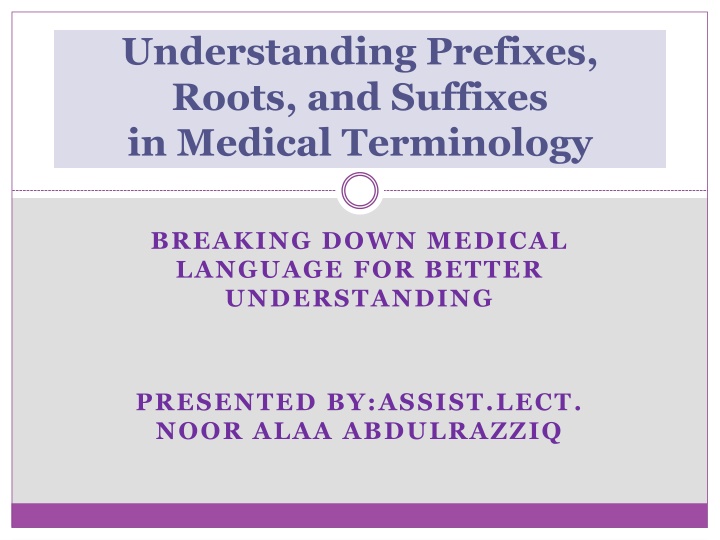
Understanding Medical Terminology: Breakdown of Prefixes, Roots, and Suffixes
Dive into the world of medical terminology by understanding prefixes, roots, and suffixes that form the language used in healthcare. Learn how these elements combine to convey complex medical concepts clearly and efficiently.
Download Presentation

Please find below an Image/Link to download the presentation.
The content on the website is provided AS IS for your information and personal use only. It may not be sold, licensed, or shared on other websites without obtaining consent from the author. If you encounter any issues during the download, it is possible that the publisher has removed the file from their server.
You are allowed to download the files provided on this website for personal or commercial use, subject to the condition that they are used lawfully. All files are the property of their respective owners.
The content on the website is provided AS IS for your information and personal use only. It may not be sold, licensed, or shared on other websites without obtaining consent from the author.
E N D
Presentation Transcript
Understanding Prefixes, Roots, and Suffixes in Medical Terminology BREAKING DOWN MEDICAL LANGUAGE FOR BETTER UNDERSTANDING PRESENTED BY:ASSIST.LECT. NOOR ALAA ABDULRAZZIQ
Introduction to Medical Terminology Medical Terminology: is the specialized language used by healthcare professionals to describe the human body, its functions, diseases, procedures, and treatments accurately and efficiently. It consists of specific words and phrases derived mainly from Greek and Latin roots, prefixes, and suffixes. These elements are combined in various ways to form terms that convey complex medical concepts clearly and concisely. Medical communication in the healthcare field, as it reduces ambiguity, allows for quick information sharing, and facilitates understanding across different languages and cultures in medical settings. terminology is essential for effective
The Building Blocks of Medical Terms Medical words are usually composed of three main components: Prefix: A word part at the beginning, often indicating number, location, time, or negation. Root: The base part, indicating the primary meaning, often a body part or condition. Suffix: A word part at the end, frequently indicating a condition, procedure, or type. Example: Hypertension Hyper- = Excessive Tension = Pressure Together: Hypertension means "high blood pressure."
Prefixes in Medical Terminology Definition and Importance Prefix: Modifies the meaning of the root by adding context often location, time, quantity, or state. Importance: Recognizing prefixes helps identify the context or severity of a condition.
Common Prefix Examples with Meanings and Medical Examples Numbers: Uni- (one) Unilateral (one-sided) Bi- (two) Bilateral (both sides) Tri- (three) Triceps (three-headed muscle) Time or Speed: Brady- (slow) Bradycardia (slow heart rate) Tachy- (fast) Tachycardia (fast heart rate) Neo- (new) Neonatal (newborn)
Location or Position: Epi- (upon, over) Epidermis (outer layer of skin) Sub- (under) Subcutaneous (under the skin) Peri- (around) Pericardium (around the heart) Negation: A- or An- (without) Anemia (without enough blood/iron) Anti- (against) Antibiotic (against bacteria)
Roots in Medical Terminology Definition and Importance Root: Provides the core meaning of the term, often relating to a body part, system, or condition. Importance: Knowing the root helps pinpoint the main subject or area of focus.
Common Roots with Meanings and Medical Examples Body Parts: Cardi- (heart) Cardiologist (heart specialist) Gastro- (stomach) Gastroenteritis (inflammation of stomach and intestines) Neuro- (nerve) Neuropathy (disease affecting nerves) Conditions: Path- (disease) Pathology (study of disease) Hem- or Hemo- (blood) Hemorrhage (excessive bleeding) Psych- (mind) Psychology (study of the mind) Processes or Actions: Therm- (heat) Thermometer (device to measure temperature) Gen- (create, form) Carcinogen (substance that can cause cancer)
Suffixes in Medical Terminology Definition and Importance Suffix: A word part that completes the term, often providing information about the procedure, condition, or disease. Importance: Suffixes help identify the type of word, whether it's a condition, a specialty, a procedure, or a type of disease.
Common Suffixes with Meanings and Medical Examples Conditions and Diseases: -itis (inflammation) Arthritis (inflammation of the joints) -osis (abnormal condition) Cirrhosis (liver disease) Procedures and Treatments: -ectomy (removal) Appendectomy (removal of the appendix) -scopy (to view) Endoscopy (viewing the inside of the body)
Specialties or Studies: -ology (study of) Neurology (study of the nervous system) -logist (specialist) Dermatologist (skin specialist) General Types: -emia (blood condition) Leukemia (blood cancer) -pathy (disease) Neuropathy (nerve disease)
Combining Forms and Vowels Explanation: When combining a root and suffix that don t naturally blend, a vowel (usually o ) is added for smoother pronunciation. Examples: Gastroenterology: Gastro- (stomach) + Entero- (intestine) + -logy (study of) Cardiovascular: Cardi- (heart) + Vascular (vessels) = related to heart and blood vessels






















